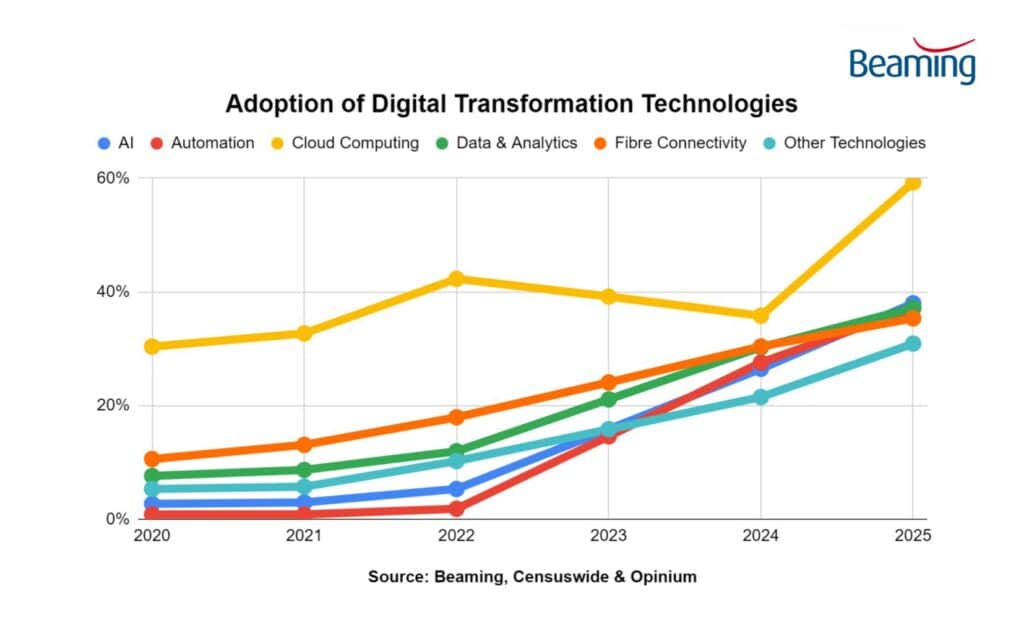Five-year view of digital transformation in UK industry
Digital transformation is essential for most businesses to thrive in today’s increasingly online environment. For some organisations, digital transformation is a massive leap into the unknown. For others, it is a journey: the ongoing adoption and integration of new tools and technologies and the willingness to learn as they proceed.
Few can afford to keep operating traditionally without at least some technological or digital assistance.
Using data from multiple surveys commissioned by Beaming with research companies Censuswide and Opinium between 2020 and 2024, we’ve assessed the adoption of various technologies associated with digital transformation:
- Artificial Intelligence (AI) is now used to support everything from customer service to sales, inventory management, financial analysis and HR, and increased from just 3% of businesses at the start of 2020 to 26% today. Our last survey, run in January, suggests that over a third (38%) of UK businesses will use AI by the end of 2024 and that more than 60% of Medium and Large enterprises already use AI.
- Automation has become a pivotal aspect of modern business operations. At the start of 2020, less than 1% of all UK businesses and just 8% of big companies used Automation to streamline tasks and minimise errors. Today, 28% of companies use Automation, with adoption rates reaching 60% and more of businesses employing more than ten people.
- Cloud Computing has been a big enabler of digital transformation, providing scalable, flexible storage, computation, and software resources to support new working methods. The adoption of Cloud Computing has increased from 30% of businesses at the start of 2020 to 36% today. However, some organisations, particularly at the smaller end of the scale, have moved away from the technology in the last couple of years due to rising costs and compliance reasons. Adoption of cloud has increased most among organisations with more than ten people. Around 40% of Small, Medium and Large businesses used the cloud in 2020. Today, adoption is close to 70%.
- The adoption of Data & Analytics and other business intelligence tools has tripled across all sizes of businesses between 2020 and 2024. Today, around two-thirds or more of Small (65%), Medium (75%), and Large (74%) companies use data and analytics to gain insights, optimise operations and inform decision-making processes.
- Fibre Connectivity has also seen significant adoption over the last few years. Our research shows that a fifth (21%) of businesses today use Fibre to the Premises (FTTP) connectivity, which delivers data all the way to their building through fibre optic cabling, and 12% now use dedicated Fibre Optic Leased Lines. Combined, the adoption of Fibre Connectivity – which provides the high speeds, high capacity and high levels of resilience required for the data-intensive applications often associated with digital transformation – by companies with more than ten people now exceeds 60%.
We also asked businesses if they were using other digital technologies to enhance business processes and drive innovation, which could include:
● Internet of Things – devices and sensors that collect and exchange data
● Blockchain – distributed ledger technology supporting peer-to-peer transactions
● Augmented Reality and Virtual Reality – technologies that enable immersive digital experiences by overlaying virtual elements onto the real world or creating entirely virtual environments.
The number of businesses adopting technologies such as these for digital transformation has doubled in the last five years and currently exceeds 60% of small, medium and large companies.
The technologies we see may have diverse uses, but they all have one thing in common: they require secure, reliable connectivity to deliver the service they promise. At Beaming, we offer that connectivity and a wealth of experience to help businesses adopt these tools successfully, sustainably and securely, and achieve the benefits of digital transformation with minimal risk.
Read next > How are businesses driving digital transformation
